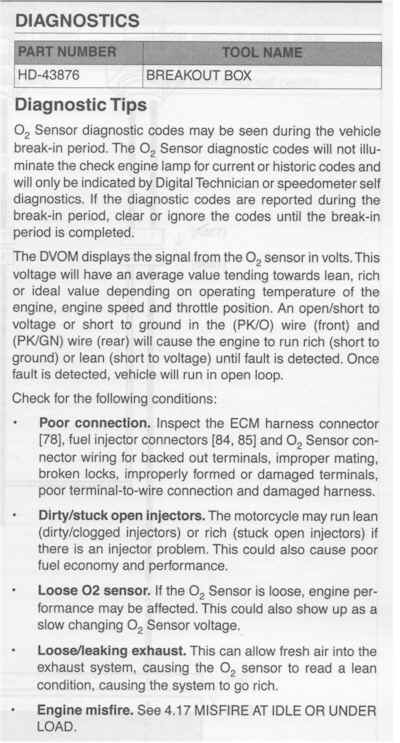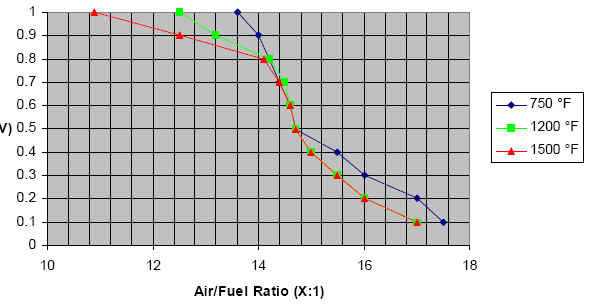131/151 Codes Explained
What do the 131/151 codes mean?
The codes are specifically listed as P0131 and P0151 codes. The description in
the Service Manual is:
P0131 Front O2 sensor low or engine running lean
P0151 Rear O2 sensor low or engine running lean
The key point to look at here is "O2 sensor low" when analyzing what
is happening with the IED's in place. The O2 sensor produces a 0.0 to 1.0 Volt
output. Any voltage lower than a preset threshold in the ECM can trigger the
131/151 errors. Lower voltage equates to a leaner fuel mixture in the eyes of
the ECM. The IED's take a higher voltage from the O2 sensor and
"shift" it to a lower voltage for the ECM to read. In some
circumstances, the ECM will see this low voltage as "too low" and
trigger the code despite the fact that the engine is running rich enough. The
IED's take advantage of this voltage shift to richen the mixture.
So the engine can be running rich and the ECM might still trigger the
"sensor low" signal.
There are also other reasons that the ECM will trigger the codes that we will
try to cover below.
Will these codes hurt my bike?
No. These are historic codes and are not active. As long as these are the
only engine codes you have and you do not have an active Check Engine light on,
they can be safely ignored.
Do all bikes get these codes with IED's installed?
No. Many bikes never see these codes. You could also have the codes and
never know it. Unless you check the historical codes on your bike, you might
never see these.
Do completely stock bikes get these errors?
Yes. Completely stock bikes get these 131/151 errors on a regular basis as
evidence that Harley has included a note to "clear and ignore" these
codes in their Service Manual.
Don't historical codes mean there is a problem?
No. Historical codes only mean the ECM saw something it did not expect.
If the code is considered a potential problem or there is a risk of damage to
the engine, the ECM will turn on the Check Engine light. No such situation
exists with the 131/151 codes. The Harley Service Manual actually notes that
these codes should be "cleared and ignored".
I have read that these codes cause the ECM to revert back to
open loop mode. Is this true?
No. The ECM will only revert to open loop operation if there is an active
error code. Active error codes will cause the Check Engine light to come on. As
long as you have no CE light, your bike will run in closed loop for normal
riding situations.
When I take the XiED's off my bike, the codes go away.
Doesn't this prove the XiED's are creating the problem?
No. It can be easy to confuse the installation of the IED's as the cause
of the error. This is a normal reaction and quite understandable for the average
rider. In engineering circles there is something known as "root cause"
analysis. The "trigger" mechanism is not always the cause of a
problem. In this case, the "trigger" is the IED's. The IED's do make
the ECM more prone to showing these codes, but there are a host of issues that
cause the codes. Harley has documented many of these causes in their Service
Manuals. A copy of the specific section of the Service Manual is listed below.
Are there other things that can cause the error codes?
Yes. We have information from an EPA testing laboratory that there are
several other issues associated with these codes. These are engineering issues
that are deeply embedded into the HD Delphi ECM. Our information also indicates
that Harley is aware of these issues, but does not have plans to create any
upgrades to eliminate know problems.
Can you get rid of the 131/151 codes?
Maybe. It is important that a rider ensure that they have eliminated the
common reasons for triggering the codes with the IED's installed. The primary
triggers are exhaust leaks and loose O2 sensors. Even the smallest exhaust leak
can trigger the codes. We have found that many of the bikes that have codes will
get rid of them when they carefully check their exhaust system.
For those bikes that have double checked their exhaust system and the errors are
still present, we have a modified XiED that might reduce the occurrence of the
codes. Contact Nightrider.com to see if you are a candidate for this upgrade.
Can I just run my bike with the codes and not worry?
Yes. As long as you do not get an active check engine light, you can run
your bike with the IED's. For any active check engine light, you want to have
that checked to find out what is setting off the CE light.
Over
the past couple of weeks we have seen a number of bikes reporting
131/151 error codes on their bikes. The fact that the majority of bikes
installing XiED's never experience any problems is a strong indication that
there are no inherent issues with the design and operation of the device. The
fact that most of the bikes that experience the 131/151 codes have the codes
eliminated after locating and eliminating very small exhaust system leaks should
be a further indication that the design is solid and the codes are caused by the
exhaust leaks.
Some
riders insist there are no leaks in the exhaust and declare the IED's defective.
I have always been willing to swap out or refund returned IED's for riders that
feel there is a problem with them. A few intrepid souls have gone through
their exhaust systems multiple times before the codes go away. It is the actions
of these riders that have convinced me that there the single cause for the
131/151 codes is fresh air getting into the exhaust system. It is also the only
explanation that matches the symptoms seen by riders.
Any
exhaust leak on a V-twin engine actually allows fresh air back into the exhaust
system. It is the interaction of this fresh air on the O2 sensor allows the code
to occur. Modern O2 sensors are incredibly accurate, sensing the smallest
changes in the amount of oxygen in the air. Even the smallest amount of fresh
air into the exhaust system is seen by the O2 sensor and results in a lower
voltage being output by the O2 sensor.
In
normal conditions, the O2 sensor produces 500mV in a 14.7:1 AFR. The ECM senses
the 500mV, recognizing this as the correct voltage to maintain. If more fuel is
added to the engine, the AFR richens, the O2 sensor voltage goes up, which
results in the ECM sensing the higher voltage as "rich" and it reduces
the amount of fuel thus leaning the engine out. If less fuel is added to the
engine, the AFR leans out, the O2 voltage goes down, which results in the
ECM sensing the lower voltage as "lean" and it increases the amount of
fuel thus richening the engine fuel mixture. This "cycling" between
rich and lean always centers on the "Bias" voltage
The
131/151 codes are set if the ECM sees a very low voltage at the O2 sensor line.
I believe this voltage is about 250mV. This normally would mean that the 02
sensor is seeing an AFR leaner than 15:0:1. But with the voltage shift of the
XiED, it means the O2 sensor is actually producing 450mV (about a 59% voltage
shift), but the ECM is reacting to the 250mV it reads as output. A few riders
seem to have "caught" the instant the ECM senses the low voltage and
noticed an engine stumble as it temporarily shifted back to open loop mode and
the leaner fuel mixture it allows. But the riders who noted this indicated the
transition from closed loop to open loop and back to closed loop was never
longer that 2-3 seconds and was only occurring at idle, generally after a long
decel. This observation is consistent with how an exhaust leak or fresh air in
the exhaust system and how an ECM should react in closed loop operation.
We
will continue to expand this article as more information becomes available.
|

|
This is the exerp from the 2008 Harley Dyna
Service Manual that talks about the 131/151 codes.
You will note that they tell you to "clear and ignore" the
codes. Their reference is primarily associated with break-in, but it seems
strange that something that is acceptable at 999 miles because an issue at
1001 miles.
Please notice HD's list of causes for 131/151 codes.
Poor Connections
Dirty Injectors
Loose O2 Sensor
Loose/Leaking exhaust
Engine misfire
We see the last three causes as primary candidates to trigger the
codes, especially with the IED's in place.
We also have evidence from a state run EPA test laboratory that codes
are very likely to be triggered just after initial startup, between the
time the engine starts and it revert to normal closed loop
operation.
|
 |
We believe the mechanism that triggers the 131/151 codes
during startup is associated with how the voltage output of the O2 sensor
changes as the sensor warms up. This graph shows how voltage output
changes with temperature. The voltage shift of the IED's could be enough
to trigger the 131/151 low voltage.
There is further evidence from the EPA testing lab that the manner in
which Harley and the ECM chooses to read the O2 sensor signals will also
cause the error.
|
|